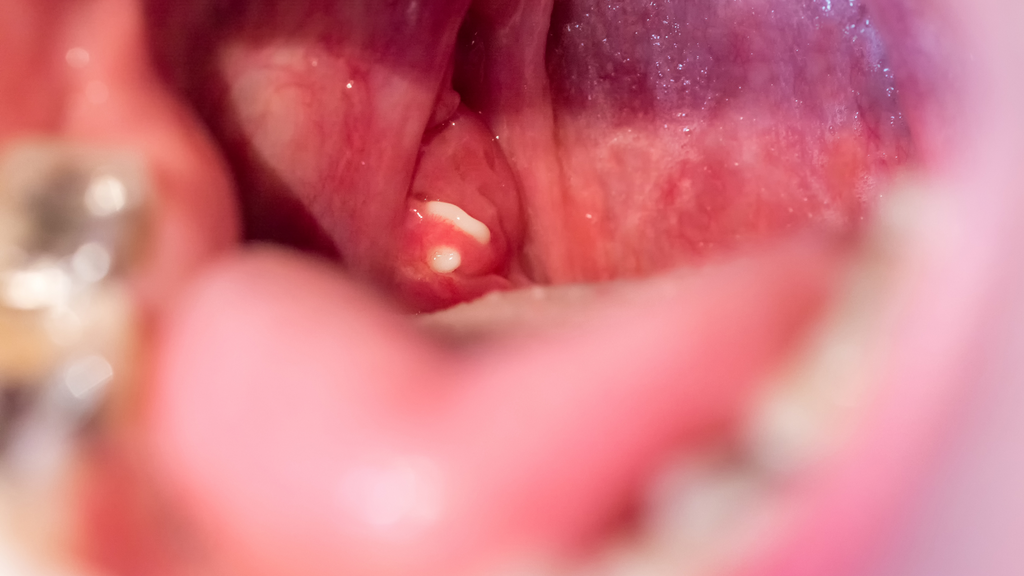
How to Remove & Treat Tonsil Stones
Tonsil stones, medically known as tonsilloliths, are whitish mineralisations of debris within the crevices of the tonsils. While they are not harmful, tonsil stones can be an unpleasant and persistent issue for many. If you've ever experienced the discomfort or bad breath associated with these small, hardened formations in your tonsils, you're not alone. In this comprehensive guide, we'll explore effective methods on how to get rid of tonsil stones and regain optimal oral health.
What Are Tonsil Stones?
Before delving into removal techniques, it's crucial to understand what tonsil stones are and what causes them. Tonsil stones are composed of calcified material, such as dead cells, mucus and food particles, that become trapped and accumulate in the crevices (crypts) of the tonsils. Tonsil stones are usually small in size, ranging from a few millimeters to a few centimeters, but they can occasionally grow larger.

Symptoms of Tonsil Stones
While tonsil stones are generally harmless, identifying tonsil stones early is essential for prompt intervention. Common symptoms include persistent bad breath (halitosis), throat irritation, difficulty swallowing, ear pain and the sensation of a foreign object lodged in the throat. Recognising these signs empowers individuals to take proactive measures in addressing the issue.
Tip: HaliTonic, a homeopathic remedy that treats the causes of bad breath, is a fantastic remedy used by many to get rid of bad smelling breath caused by tonsil stones. Click here to view HaliTonic
How to Treat Tonsil Stones
Treatment for tonsil stones may not always be necessary, especially if they are small and not causing symptoms. However, larger or symptomatic tonsil stones may require removal. This can often be done at home using the following methods:
1. Gargle with Salt Water
A simple yet effective remedy for tonsil stones is regular gargling with salt water. This natural solution helps to dislodge and dissolve the stones, reducing inflammation and providing relief. Mix a teaspoon of salt in warm water and gargle thoroughly, ensuring the solution reaches the affected areas.

2. Maintain Excellent Oral Hygiene
Prevention is often the best cure. Establishing a consistent oral hygiene routine, including brushing your teeth, tongue, and using oil pulling, can significantly reduce the likelihood of tonsil stone formation. This proactive approach combats the accumulation of debris and bacteria in the oral cavity, preventing problems such as tonsil stones from occurring.
Click here to view Oil Pulling Sachets

3. Gentle Manual Removal
For those comfortable with a hands-on approach, gently removing tonsil stones with a cotton swab or the back of a toothbrush can be effective. Exercise caution to avoid triggering a gag reflex or causing injury to the delicate tonsil tissues. This method is best suited for visible or superficial tonsil stones.
4. Apple Cider Vinegar Rinse
The acidic nature of apple cider vinegar makes it a potent ally in combating tonsil stones. Mix a tablespoon of apple cider vinegar with warm water and use it as a gargle. The acidity helps break down the stones, providing relief from discomfort and preventing their recurrence.
Click here to view Apple Cider Vinegar
5. Stay Hydrated
Adequate hydration plays a crucial role in preventing the formation of tonsil stones. Drinking plenty of water helps flush out debris and bacteria from the mouth, maintaining optimal oral health. Make it a habit to stay well-hydrated throughout the day.

6. Natural remedies
Natural remedies can be effective in managing tonsil stones and reducing symptoms. One of the top remedies to help treat tonsil stones is Throat & Tonsil Dr, a homeopathic remedy that improves the overall health of the throat and tonsils, and reduce infections. Integrating probiotics into your diet can contribute to a healthier oral microbiome. These beneficial bacteria help maintain a balanced environment in the mouth, reducing the chances of bacterial overgrowth and the formation of tonsil stones.
Click here to view Throat & Tonsil Dr
7. Use a Water Flosser
A water flosser, or oral irrigator, is an excellent tool for removing debris and bacteria from hard-to-reach areas in the oral cavity. Regular use can prevent the accumulation of material that contributes to tonsil stone formation.

8. Avoid Dairy Before Bed
Dairy products, especially milk, can contribute to the development of tonsil stones. Consuming dairy before bedtime can lead to increased mucus production, providing an ideal environment for stone formation. Consider adjusting your dietary habits for a noticeable improvement.
9. Seek Professional Guidance
In persistent cases or when dealing with large tonsil stones, seeking advice from a healthcare professional or an ear, nose, and throat (ENT) specialist is advisable. They can provide personalised recommendations and, if necessary, perform procedures to address the issue.
Conclusion
In conclusion, the journey to a tonsil stone-free life involves a combination of proactive measures and effective remedies. From simple home remedies to professional guidance, the key lies in understanding your body and adopting habits that promote oral health. With these strategies in your arsenal, bid farewell to tonsil stones and embrace a breath of fresh air and confidence in your oral well-being.
Featured products:
Related Articles:
- Bad Breath: Causes, Treatment & Prevention
- Simple Oil Pulling Detox For Whiter Teeth
- Natural Teeth Whitening At Home
If you have any health-related questions, please contact us or leave a comment below for FREE advice. We always love hearing from you!


Comments
Leave a comment